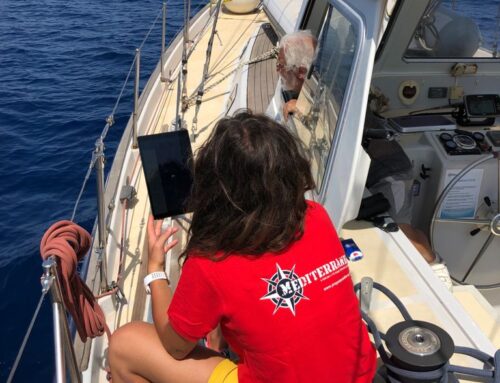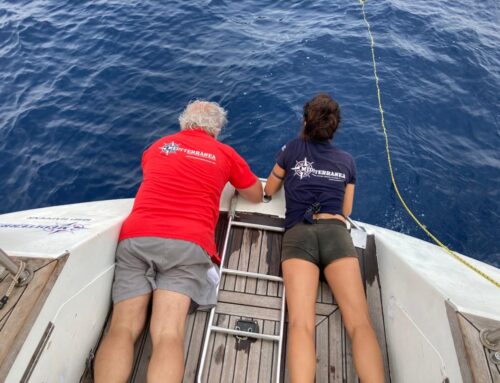36° 46.014 N – 24° 36.660 E
July 24th, 15:00 local time
Polyaigos
”Just few words aboard Mediterranea, lots of tears of emotion, silence. It swam with us and we did with it. An hour long. Then it swam quickly to the bottom of the sea. As if to take leave of us and we let it go. We are grateful for the pure joy it gave us. It did not flee. It stayed with us. An hour long. Up, down, up, down, with us. An hour long. It measured around 80 cm long and 40 cm wide. Light, calm, placid but quick when necessary. In the morning we had left Karavostasis bay in Folegandros heading for Milos, when we decided to pass the night in Monolysis. The place is beautiful, crystal-clear water, a first layer of white rock and a second one of dark volcanic rock originated by later eruptions. Kimolos and Milos islands just before us. All of a sudden two Greek men on a tiny motorboat shouted “Caretta caretta…camera camera”. We took the underwater camera and the boat’s tender, as fast as possible, we dived, the tender floating off (it’s all right, intact) for a good reason. We saw it, we got closer, someone with mask and flippers, and the dance began. That evening on board we celebrated.”
The words are by Giuliana, the Rais in command of Mediterranea last July, describing the surprising encounter with a loggerhead sea turtle (Caretta caretta).
Polyaigos is an uninhabited Greek island in the Cyclades, lies a mile southeast of Kimolos and near Milos. Its name means “many goats”, since it has always been inhabited only by goats. Since 2000 Polyaigos is part of Natura 2000 ecological network, a European Union network of nature protection areas. This is a birth and life area for the monk seal (Monachus monachus), as the habitat is undisturbed by human presence and, thus, inhabited by beautiful and fascinating sea creatures.
The loggerhead sea turtle (Caretta caretta) is the most common turtle in the Mediterranean sea. It is seriously endangered by the systematic destruction of its natural habitat, it survives in some specially protected areas. In Italian territorial waters the Caretta caretta is threatened with extinction.
The loggerhead sea turtle adapted to life in sea waters, it has a rhomb-shaped shell (carapace) and its strong paws developed into flippers: forepaws are stronger, hind paws have a weaker muscular build and work as a drift when swimming. It measures between 80 and 140 cm long when fully grown. The top shell is characterized by five large side plastrons, that distinguish it from the green sea turtle, which is also to be found in the Mediterranean.
It feeds of plankton, soft corals, sea vegetables growing on rocky bottoms, which it pulls out with its powerful jaws. Every 15-20 minutes it emerges to breathe.
Caretta caretta go back to their birth areas for reproduction. This is the reason why those areas are to be protected and, thus, reported to reference centres. In those same areas turtles go back again and again over their lifetime, thanks to a mysterious and extraordinary ability to find their place of birth even when they are thousands kilometre away. According to studies, new-born loggerheads can store their nest coordinates thanks to Earth’s magnetic field, pheromones and environmental characteristics. A sort of imprinting of their birth place which is imprinted onto them. Therefore, once broken the eggshell and left their nest, baby turtles shall be able to reach the sea untouched either by human hands or other animals, as that would make them lose their nest memory irreversibly. It takes 20-25 years until the turtle becomes an adult and starts reproduction. Nest memory belongs to its genetic heritage and it helps not to lose its way when, 25 years later, it will go back to the hot sand of the beach where it was born. Caretta caretta knows its roots and, unlike human beings, does not forget its origins.
In Greece, the largest marine protected area is in Zakinthos (Zante), where the National Marine Park established in 1999 is under the continuous threat of pollution from a landfill site within the park. On July 28th 2014 the European Court of Justice condemned Greece once again for jeopardizing environmental protection. Other protected areas are in Cephalonia, Rhodes and Cyprus.





Leave A Comment